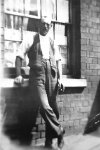Lizzie
I assume you have read the later post where I have given the details for Vauxhall Road.
Nowadays I do not think renumberings are that common. That said, if a building occupies a double or more plot, and thus is technically (say)
10&12, it is often just listed as either 10 or 12, and there is no certain way of knowing that, and indeed sometimes this changes in directories depending on which year you are looking at. Below I will try and explain further , but my emphasis is on Birmingham, of which have some knowledge
Going back to earlier years, originally buildings were not usually numbered. Indeed in small villages up till around the second world war this was quite common. On one occasion I was trying to elucidate the occupants of an old house in a village in Oxfordshire and none of the available censuses (up to 1911) showed any house numbers in the centre of the village and they only appeared on the electoral roll after WW2, before then being listed in alphabetical order (you will note I said "trying to" - I only managed up till 1911 by looking at and comparing neighbours on the censuses). In the early 19th century some numbering came in, mainly in towns, but it was not complete and often builders of a terrace would just number the terrace1,2,3... such and such a terrace. Slowly numbering came in, though often one part of a road might be numbered while others had no numbering, or possibly only he terrace numbering previously mentioned. This largely changed around 1860 and streets were largely (in towns) numbered (though to confuse matters the numberings , particularly of factories, was not always shown. this initial numbering was usually consecutive (1,2,3...) up one side of the road, and then down the other side. However, as towns expanded roads were lengthened or combined with others which led to problems, such as if a road consecutively numbered ended one side at say number 30, but was then extended - what do you call the buildings . Therefore around 1882-6 (in Birmingham) many roads were renumbered odd one side, even the other. A handful were similarly renumbered a few years later. I say in Birmingham, though I gather that in London a large renumbering occurred between the 1st and 2nd world wars.
As a matter of interest, there have been some recent discussions among"mappy"people on numbering. It has been pointed out by a town planner that (in his area) " streets with no. 1 on the right at the end nearer to the centre." Also that mapmakers on more recent large scale maps such as the one I posted for you for Dollman street were instructed to number the first and last house and also every fifth house. Interestingly to also always mark no 13, as some councils deliberately missed out no 13 (!!), so this would show whether this had occurred.
Sorry for going on, but hope you found it of interest. Basically you have to look at each case separately. I do it with a combination of available maps, directories and online electoral rolls









